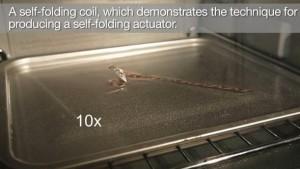If you thought that the 3D printed robot named Jimmy, which Intel has been showing off this past week was cool, then you will really be impressed by a project that is being worked on by MIT researchers.
 When picturing our future, and the role in which technology will play within it, we all likely envision robot helpers, making life easier, while providing all sorts of human-like interactions with their owners. What we probably didn’t envision, however, is that we may be 3D printing out our own robot in a flat sheet of material, which when put into the oven, self assembles. That kind of technology is even outside the realm of the Star Trek writer’s imagination – not MIT researchers though.
When picturing our future, and the role in which technology will play within it, we all likely envision robot helpers, making life easier, while providing all sorts of human-like interactions with their owners. What we probably didn’t envision, however, is that we may be 3D printing out our own robot in a flat sheet of material, which when put into the oven, self assembles. That kind of technology is even outside the realm of the Star Trek writer’s imagination – not MIT researchers though.
Daniela Rus, who is a professor of electrical engineering and computer science, as well as director of the Computer Science and Artificial Intelligence Laboratory (CSAIL) at MIT, has been working with a team of researchers to produce 3D printed robotics. This weekend Rus and her team will be showing off their research, and the progress they have made, at the IEEE International Conference on Robotics and Automation in Hong Kong.
Rus envisions that one day we will be able to print robots on demand, which have all the electronics built into them. The new work she has been doing, allows for the printing of a material in 2D. The material is made up of a sheet of polyvinyl chloride (PVC), which is then placed between two pieces of film, both made up of polyester with various  sized slits in them. When this 2D material is heated, the PVC contracts, forcing the slits in the polyester to close. This then causes the PVC to deform. By placing slits in specific locations, the team is able to dictate how the material will fold when heated, creating a pre-planned 3D object. Determining where to place the slits on the polyester foil, however, is not an easy task.
sized slits in them. When this 2D material is heated, the PVC contracts, forcing the slits in the polyester to close. This then causes the PVC to deform. By placing slits in specific locations, the team is able to dictate how the material will fold when heated, creating a pre-planned 3D object. Determining where to place the slits on the polyester foil, however, is not an easy task.
“You’re doing this really complicated global control that moves every edge in the system at the same time,” Rus stated. “You want to design those edges in such a way that the result of composing all these motions, which actually interfere with each other, leads to the correct geometric structure.”
Shuhei Miyashita, a postdoc working with Rus on this research, is credited for another paper in which she demonstrates how to create foldable electronics. By coating a polyester material with aluminum, Miyashita and her team at the University of Zurich and the University of Tokyo, were able to create a sensor, which looks like an accordion. Every one of the folds in the accordion has a resistor, so that when the folds are compressed, there is a change in resistance, which leads to a change in the current that is able to pass through the sensor. Miyashita’s team hopes to later create a similar accordion like device, this time coated with copper, rather than aluminum. This device could act as an actuator, enabling the robot to move.
The research done by both Rus and Miyashita will hopefully one day lead to advanced 3D printable robotics, where both the electronics, as well as the exterior hardware can be printed together. We aren’t there yet, but are getting closer.
“We have this big dream of the hardware compiler, where you can specify, ‘I want a robot that will play with my cat,’ or ‘I want a robot that will clean the floor,’ and from this high-level specification, you actually generate a working device,” Rus says. “So far, we have tackled some subproblems in the space, and one of the subproblems is this end-to-end system where you have a picture, and at the other end, you have an object that realizes that picture. And the same mathematical models and principles that we use in this pipeline we also use to create these folded electronics.”
As the exponential progress in both the fields of 3D printing , as well as robotics converge, research among the combined field will become almost scary, as advancements will progress at a level many of us may not be able to comprehend. The next decade or so, will certainly be an interesting one for both technological fields. Tell us your opinion on 3D printed robotics, at the 3DPB.com forum thread. Check out the video below, provided by MIT, on the research discussed in this article:
(Source: MIT)
Subscribe to Our Email Newsletter
Stay up-to-date on all the latest news from the 3D printing industry and receive information and offers from third party vendors.
You May Also Like
3D Printing News Briefs, April 27, 2024: Research, Digital Dentistry, Cycling, & More
We’re starting today’s 3D Printing News Briefs with some research into 3D printed luminescent quantum-dot polymer architectures and free-form laser beam shaping, and then on to an open source 4-axis...
HP & INDO-MIM Collaborate to Boost Metal 3D Printing in India
HP Inc. and INDO-MIM, a US- and India-based supplier of metal injection molding (MIM) powders and contract manufacturer, have announced that the two companies will collaborate to accelerate additive manufacturing...
3D Printing News Briefs, February 17, 2024: Shot Blasting, Service Bureaus, & More
In today’s 3D Printing News Briefs, we’re starting out with post-processing, as SKZ Würzburg is using a shot blast system from AM Solutions for its research. Moving on to business,...
3D Printing News Unpeeled: Not That Kind of Organ 3D Printing
GKN Aerospace will create a 150 jobs in Trollhattan Sweden with an investment of $60 million part of which comes from the Swedish Energy Agency’s Industriklivet initiative. The investment will...
































